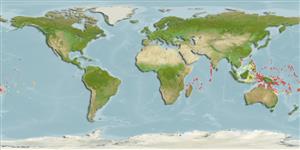Environment: milieu / climate zone / depth range / distribution range
Ökologie
seewasser riff-verbunden; tiefenbereich 1 - 10 m (Ref. 1602). Tropical; 19°N - 24°S
Indo-Pacific: Chagos Islands, Philippines, Great Barrier Reef, Fiji, and Samoa; Mariana, eastern Caroline and Marshall Islands in Micronesia.
Size / Gewicht / Alter
Maturity: Lm ? range ? - ? cm
Max length : 2.3 cm TL Männchen/unbestimmt; (Ref. 2334)
Kurzbeschreibung
Bestimmungsschlüssel | Morphologie | Morphometrie
Rückenflossenstacheln (insgesamt) : 7; Rückenflossenweichstrahlen (insgesamt) : 7 - 9; Afterflossenstacheln: 1; Afterflossenweichstrahlen: 7 - 9. Characterized by semi-transparent head and body with white internal pigment over brain; upper surface of vertebral column white internal white stripe; ventral half of body with six faint reddish internal bars; lower half of body obscured by reddish brown to violet brown or purple streak and ending at caudal fin base; presence of brown saddles along back; all pectoral rays usually unbranched; longitudinal scale series 34-49; broad and disc-like pelvic fins, reaching to anus or beyond; opening of gill usually reaching to below rear edge of eye (Ref. 90102).
Lives on certain branching coral forms of fire coral (Millepora spp.) and on other massive corals ones (e.g. like Porites cylindrica, P. lutea) in shallow lagoons at depths of 1 to 10 m.
Life cycle and mating behavior
Maturities | Fortpflanzung | Spawnings | Egg(s) | Fecundities | Larven
Myers, R.F., 1991. Micronesian reef fishes. Second Ed. Coral Graphics, Barrigada, Guam. 298 p. (Ref. 1602)
IUCN Rote Liste Status (Ref. 130435)
Bedrohung für Menschen
Harmless
Nutzung durch Menschen
Tools
Zusatzinformationen
Download XML
Internet Quellen
Estimates based on models
Preferred temperature (Ref.
123201): 26.6 - 29.3, mean 28.5 °C (based on 1364 cells).
Phylogenetic diversity index (Ref.
82804): PD
50 = 0.5000 [Uniqueness, from 0.5 = low to 2.0 = high].
Bayesian length-weight: a=0.00708 (0.00333 - 0.01504), b=3.09 (2.92 - 3.26), in cm total length, based on LWR estimates for this (Sub)family-body shape (Ref.
93245).
Trophic level (Ref.
69278): 3.0 ±0.3 se; based on size and trophs of closest relatives
Widerstandsfähigkeit (Ref.
120179): hoch, Verdopplung der Population dauert weniger als 15 Monate. (Preliminary K or Fecundity.).
Fishing Vulnerability (Ref.
59153): Low vulnerability (10 of 100).
Nutrients (Ref.
124155): Calcium = 504 [207, 1,842] mg/100g; Iron = 1.96 [0.74, 4.73] mg/100g; Protein = 17.6 [15.4, 19.6] %; Omega3 = 0.093 [0.026, 0.331] g/100g; Selenium = 35.6 [8.5, 127.2] μg/100g; VitaminA = 87.7 [14.0, 525.9] μg/100g; Zinc = 5.49 [2.71, 9.77] mg/100g (wet weight);
